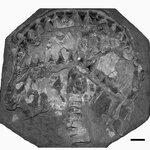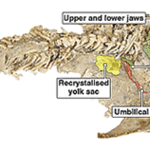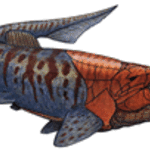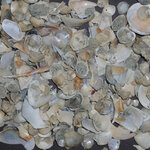Paleontology

Sharks are among the most popular animals featured in television and cinema. And today among sharks, the undisputed king is the great white, a giant predator that can exceed 20 feet in length. Despite the popularity of great whites, relatively little is known about their biology, and even less is known about their evolutionary origins. A new 4-million-year-old fossil from Peru described in the Journal of Vertebrate Paleontology provides important evidence suggesting the shark’s origins may be more humble than previously believed.
Fossil shark skeletons are extremely rare because sharks do not…

"Wow!" "Look, look here. Is it a dinosaur? A T-Rex? A deer? What is it?" Those who've chased elusive fossils and cracked concretions know these gleeful questions well. The rush and excitement of finding a perfectly preserved skull, tooth or even wee toe bone from the distant past is always a delight.
In the John Day Formation near Kimberly, Oregon, more than a 100 groups of mammals have been found all beautifully preserved in the early Miocene (37 – 20 mya) strata. The familiar are found along side the more exotic... many of the fossil mammals found are familiar as we have domesticated their…

As part of the Eighth BC Paleontological Symposium, May 15-18, 2009, I led a field trip to the Cretaceous-Jurassic exposures near Harrison Lake, British Columbia. The lake and hotsprings at Harrison are an easy two hour drive from Vancouver and another hour or so to our final destination, the unyielding siltstone of the Callovian Mysterious Creek Formation.
A few hours of collecting yield multiple bivalves, ammonites, including what looks to be two new species. Amongst the best specimens of the day are several small, fairly well preserved Cadoceras (…
When Alan Pradel of the Muséum National d'Histoire Naturelle in Paris CAT scanned a 300-million-year-old fossilized iniopterygian from Kansas, he and his colleagues saw a symmetrical blob nestled within the braincase.
This turned out to be the oldest brain found in fossil form, a wholly unexpected and rare discovery.
Additional scanning on the synchrotron at the European Synchrotron Radiation Facility in Grenoble, France (and using a new X-Ray approach) yielded detailed information about the structure of brain, the shape of the braincase, and the nerves running between the two features. The…

A 380-million-year-old fossil fish that shows an unborn embryo and umbilical cord has been discovered, write scientists from the Natural History Museum in Nature. The extremely rare specimen shows incredible detail. The umbilical cord is attached to an area of small bones, corresponding to the embryo. This means the fish would have given birth to live young, known as viviparity and is the oldest record of this kind known.
'The find is important because it provides concrete evidence for vivparity,' says Zerina Johanson, fossil fish curator at the Natural History Museum.
Fossil specimen…

A pregnant fossil fish at the Natural History Museum in London has shed light on the possible origin of sex, according to a study published today in the journal Nature by an international team including Museum scientists.
The fossil is an adult placoderm, an extinct group of armored fish, and it contains a 5cm-long embryo. It is dated to the Upper Devonian period 350 million years ago and was found in the Gogo formation of western Australia. The fish species is Incisoscutum ritchiei and this specimen is one of the earliest examples of a pregnant vertebrate and shows that internal…

New evidence of a carnivorous killer has been found in Africa. This ancient killer almost had the misfortune of going extinct twice.
While evidence of 95-million year old therapods from Africa is quite scare making one think that each fragment would be treated like gold, this was not the case the first evidence of Carcharodontosaurus iguidensis, a newly described dinosaur from the Cenomanian of Nigeria and published in the December 2007 issue of the Journal of Vertebrate Paleontology.
Tooth fragments collected by Charles Depéret and J. Savornin in 1927 were misplaced before this meat-…

The Paleontologist community in China and around the world are all aflutter over a recent find in the Erlian Basin of Inner Mongolia.
Known more for its heavy oil potential and favorite export - pollution, northeastern China is the preferred stomping ground for the savvy petroleum geologist. As a complete aside, it also boasts the prettiest portion of the gene pool, or so says one of my stomping friends having explored much of Asia. So, home to pretty women today and, as it would seem, an enormous bird-like dinosaur some 70 million years ago.
Fancy that.…

Sunshine, salt air, the bark of seals and... fossils await for those lucky enough to beach comb the fossiliferous shores near the fishing community of Sooke on Vancouver Islands' southwestern edge.
Sooke was originally inhabited by the T'sou-ke, a group related to the Salishan First Nations, who found the mild climate and sea access ideal. A fossil field trip brought me there last summer to explore the tidepools and well preserved marine fossils near the seaside exposures at Muir Creek.
Along the beachfront, you can find blocks of late Oligocene, 20-25 million year old,…

Paleontologists can still hear the echo of the death knell that drove the dinosaurs and many other organisms to extinction following an asteroid collision at the end of the Cretaceous Period 65 million years ago.
"The evolutionary legacy of the end-Cretaceous extinction is very much with us. In fact, it can be seen in virtually every marine community, every lagoon, every continental shelf in the world," said University of Chicago paleontologist David Jablonski. It is, he said, "sort of an echo of the big bang for evolutionary biology."
This conclusion followed a detailed global analysis of…